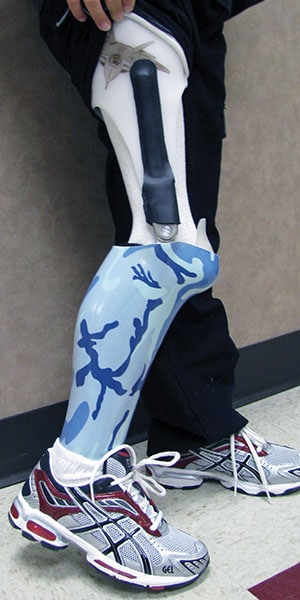Shared from inMotion | Volume 28, Issue 5 | September/October 2018, Page 40
by Tony Phillips

“I had three options,” says Miller: “amputation above the knee, a hinged endoprosthesis (installed inside the leg) and limb salvage, or rotationplasty.” Miller and his parents took option three, a procedure that involves resection (removal) of the lower femur and upper tibia (thigh bone and shin bone, respectively), followed by direct attachment of the two bones with the ankle rotated 180 degrees, such that the foot faces backward on a shortened leg and the ankle takes the place of the knee.
“It’s still primarily a procedure performed on bone cancer patients,” Miller explains, noting that the procedure is not yet universally accepted by orthopedic surgeons. “But recently there was a case of a patient injured in a motor vehicle accident. It just so happened that the surgeon, who was completing his residency, had researched the procedure online and knew it was an option when he examined the patient. As a result, that patient now has a functional knee.”
While it remains less common than other procedures, there are notable advantages to rotationplasty as opposed to the traditional transfemoral amputation. “A foot is a natural weight-bearing structure,” says Miller, an avid water and snow skier who played baseball, basketball and football as a high school athlete.
Miller’s interest in rotationplasty is both personal and professional. He is the Southeast regional vice president of Hanger, Inc., one of the country’s leading providers of prosthetic and orthotic services and supplies. He is also a certified prosthetist, working out of Hanger’s Savannah, Georgia facility.
“Many prosthetists may go their whole career and not have the opportunity to fit a rotationplasty patient,” Miller says. “I have personal experience with what works and what doesn’t work. I know how to take care of the foot, how to ensure proper fit and function of the prosthesis, and also the long-term effects of improper fit and other issues.”
“With a rotationplasty,” Miller adds, “you have to realize there’s a functional foot interfacing with the prosthesis. Not only does the planar surface allow for weight bearing, the toes are also there for balance and to aid in powering the prosthesis, as well as assisting with suspension and lengthening the lever arm. It’s entirely different from a typical below-knee configuration. With ill-fitting prostheses, I’ve seen issues ranging from cramping of the toes to overextension of the ankle and a whole range of other issues.”
As a rotationplasty patient who fits rotationplasty patients, Miller is among the rarest of specialists in a highly specialized industry. His unique combination of personal experience and professional expertise place him in high demand.
“My first prosthesis didn’t fit correctly and I developed sores and other complications,” Miller says. “I tried to be active and the skin sheared off of areas of my leg. Eventually I found a local provider who was up-to-speed with innovative prosthetic fitting and he built me a prosthesis that was perfect. It was life-changing. I think that experience is what got me into my field.”
“Unfortunately,” adds Miller, “some prosthetists say they can build a rotationplasty prosthesis, but what they build ends up causing problems that are harder to fix down the road. I’ve seen cases of impingement (compressed tissue) in the ankle complex and other issues that set back the patient’s mobility and quality of life.”
Miller says, “I’m always happy to consult with other prosthetists and share what I’ve learned.” Calls for his expertise are increasingly frequent, as rotationplasty becomes a more common procedure: “I know of a patient who was in his 70s when he had rotationplasty, and his recovery and adaptation to the prosthesis have been fantastic.”
“I think it’s important that prosthetists reach out to colleagues,” Miller says. “I also think it’s important for patients to use some diligence in deciding whether rotationplasty is right for them. They should consult with their surgeon and find out not only his or her experience with the procedure, but also what they should expect in terms of recovery. Considering all the variables, weighing the increased functionality against any perceived cosmetic issue, I think the benefits of rotationplasty versus above-knee amputation are clear.”

An Explanation of the Rotationplasty and Tibia Turn-Up Procedures
amputee-coalition.org/resources/an-explanation-of-rotationplasty
Rotationplasty
(Membership applicants are screened prior to admission) facebook.com/groups/rotationplastyresource
©2018 Amputee Coalition LLC | Amputee-coalition.org | 888-267-5669
Published in inMotion, Volume 28, Issue 5 | September/October 2018, Page 40


